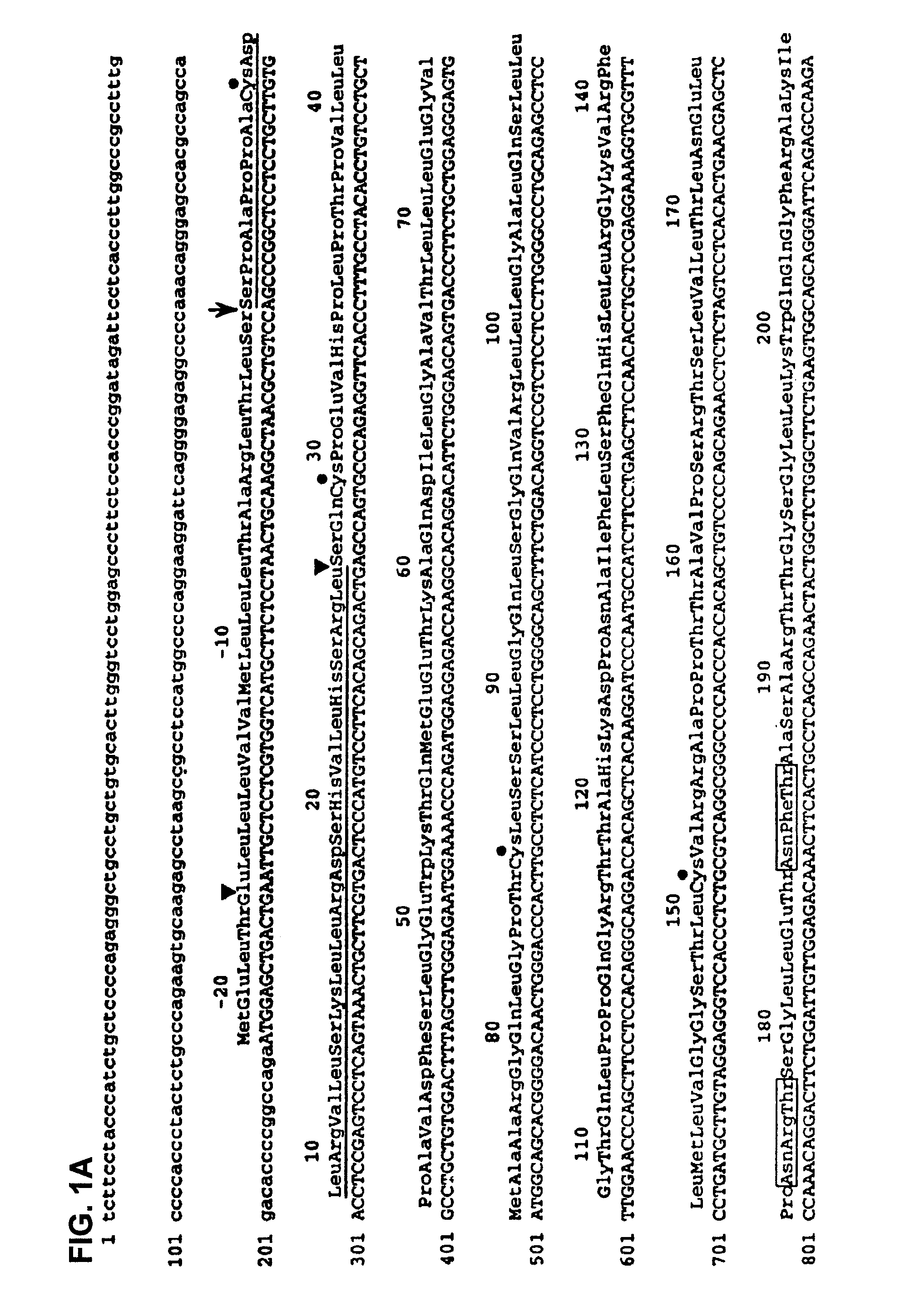Monoclonal antibody to human thrombopoietin
a technology of human thrombopoietin and monoclonal antibody, which is applied in the field of monoclonal antibody to human thrombopoietin, can solve the problems of complex and incomplete role of these growth factors in vivo, thrombocytopenia may develop due to dilution, and attendant immune and viral risk
- Summary
- Abstract
- Description
- Claims
- Application Information
AI Technical Summary
Benefits of technology
Problems solved by technology
Method used
Image
Examples
example 1
Partial Purification of the Porcine Mpl Ligand
[0480]Platelet-poor plasma was collected from normal or aplastic anemic pigs. Pigs were rendered aplastic by irradiation with 900 cGy of total body irradiation using a 4 mEV linear accelerator. The irradiated pigs were supported for 6-8 days with intramuscular injections of cefazolin. Subsequently, their total blood volume was removed under general anesthesia, heparinized, and centrifuged at 1800×g for 30 min. to make platelet-poor plasma. The megakaryocyte stimulating activity was found to peak 6 days after irradiation.
[0481]Aplastic porcine plasma obtained from irradiated pigs is made 4M with NaCl and stirred for 30 min. at room temperature. The resultant precipitate is removed by centrifugation at 3800 rpm in a Sorvall RC3B and the supernatant is loaded onto a Phenyl-Toyopearl column (220 ml) equilibrated in 10 mM NaPO4 containing 4M NaCl. The column is washed with this buffer until A280 is 2O. The eluted protein peak is diluted with ...
example 2
Highly Purified Porcine Mpl Ligand
Gel Elution Protocol
[0487]Equal amounts of affinity purified mpl ligand (fraction 6 eluted from the mpl-IgG column) and 2× Laemmli sample buffer were mixed at room temperature without reducing agent and loaded onto a Novex 4-20% polyacrylamide gel as quickly as possible. The sample was not heated. As a control, sample buffer without ligand was run in an adjacent lane. The gel was run at 4-6° C. at 135 volts for approximately 2 ¼ hours. The running buffer was initially at room temperature. The gel was then removed from the gel box and the plate on one side of the gel removed.
[0488]A replica of the gel was made on nitrocellulose as follows: A piece of nitrocellulose was wet with distilled water and carefully laid on top of the exposed gel face so air bubbles were excluded. Fiducial marks were placed on the nitrocellulose and the gel plate so the replica could be accurately repositioned after staining. After approximately 2 minutes, the nitrocellulose ...
example 3
Porcine Mpl Ligand Microsequencing
[0490]Fraction 6 (2.6 ml) from the mpl-IgG affinity column was concentrated on a Microcon-10 (Amicon). In order to prevent the mpl ligand from absorbing to the Microcon, the membrane was rinsed with 1% SDS and 5 μl of 10% SDS was added to fraction 6. Sample buffer (20 μl) of 2× was added to the fraction #6 after Microcon concentration (20 μl) and the total volume (40 μl) was loaded on a single lane of a 4-20% gradient acrylamide gel (Novex). The gel was run following Novex protocol. The gel was then equilibrated for 5 min. prior to electroblotting in 10 mM 3-(cyclohexylamino)-1-propanesulfonic acid (CAPS) buffer, pH 11.0, containing 10% methanol. Electroblotting onto immobilon-PSQ membranes (Millipore) was carried out for 45 min. at 250 mA constant current in a BioRad Trans-Blot transfer cell (32). The PVDF membrane was stained with 0.1% Coomassie Blue R-250 in 40% methanol, 0.1% acetic acid for 1 min. and destained for 2.3 min. with 10% acetic acid...
PUM
| Property | Measurement | Unit |
|---|---|---|
| diameter | aaaaa | aaaaa |
| temperature | aaaaa | aaaaa |
| ionic strength | aaaaa | aaaaa |
Abstract
Description
Claims
Application Information
 Login to View More
Login to View More - R&D Engineer
- R&D Manager
- IP Professional
- Industry Leading Data Capabilities
- Powerful AI technology
- Patent DNA Extraction
Browse by: Latest US Patents, China's latest patents, Technical Efficacy Thesaurus, Application Domain, Technology Topic, Popular Technical Reports.
© 2024 PatSnap. All rights reserved.Legal|Privacy policy|Modern Slavery Act Transparency Statement|Sitemap|About US| Contact US: help@patsnap.com










